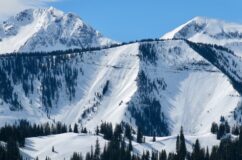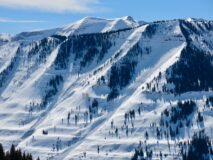Date of Observation: 03/02/2022
Name: Evan Ross
Zone: Northwest Mountains
Route Description: Washington Cultch, mostly southerly facing slopes BTL/NTL.
Observed avalanche activity: Yes
Avalanches: A couple of fresh slab avalanches off of Schuylkill Ridge. Both were D2 in size and released at 11,200ft. One released on a northeast aspect and the other an east aspect. I suspect there were triggered by loose snow avalanches coming off the rocks or sunny slopes above. As the avalanches ran they entrained wet snow.
Various loose wet avalanches that have run in recent days on steep sunny slopes. Nothing particularly notable.
Weather: Hot and sunny. Calm winds. A few clouds came through.
Snowpack: Looked in various locations on SE to W looking at the wet snow and if water was creating issues as it encountered the mid-February weak interface. In a quick summary, I didn’t end up finding a particularly concerning area where water was hitting or about to hit a dry weak layer. Surface cracks in the top couple inches of the snowpack were everywhere, similar to what you may see in the springtime as the snowpack is rapidly changing.
10,800ft on SE and SW. The recent round of water had made it to the mid-February interface and I didn’t find a particular slab concern. Water had previously drained below the mid-February interface and created various percolation columns below those crusts and into the larger grained melt forms or facets below. Of course, there is variation in snowpack structure based on slope angle, and how big their drainage is, such as concave slopes or slopes below cliff bands.
11,600ft, SE aspect, 30-degree slope. The water had made it to the mid-February crust and was running along the crust at this location. After the pit was dug you could see the water continuing to accumulate in the pit wall. In this location, water had also previously drained below the crust, earlier in the month, and into the larger grained facets. A CT test produced no results.
West between 10,200ft and 10,600ft. The upper 2 to 3″ of snow was wet. While the 1 to 2-foot slabs on the mid-February interface were dry with no water close to the interface. Addintally, traveling in this area at the end of last week I had encountered many collapses and shooting cracks. Now everything was quiet, but the snowpack structure still remained concerning for the PSa problem.
Photos:




